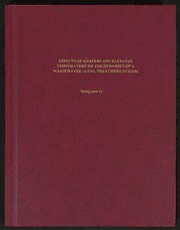
Effects of Grazers and Elevated Temperature on the Dynamics of a Wastewater Algal Treatment System PDF
Preview Effects of Grazers and Elevated Temperature on the Dynamics of a Wastewater Algal Treatment System
EFFECTS OF GRAZERS AND ELEVATED TEMPERATURE ON THE DYNAMICS OF A WASTEWATER ALGAL TREATMENT SYSTEM Mengyuan Li EFFECTS OF GRAZERS AND ELEVATED TEMPERATURE ON THE DYNAMICS OF A WASTEWATER ALGAL TREATMENT SYSTEM A thesis submitted to the College of Letters and Science in partial fulfillment of the requirements for the degree of MASTER OF SCIENCE DEPARTMENT OF EARTH AND SPACE SCIENCE by Mengyuan Li fail _■—-- . Dr. Clinton I. Barineau, Department Chair COLUMBUS STATE UNIVERSITY EFFECTS OF GRAZERS AND ELEVATED TEMPERATURE ON THE DYNAMICS OF A WASTEWATER ALGAL TREATMENT SYSTEM A THESIS SUBMITTED TO THE COLLEGE OF LETTERS AND SCIENCE IN PARTIAL FULFILLMENT OF THE REQUIREMENTS FOR THE DEGREE OF MASTER OF SCIENCE DEPARTMENT OF EARTH AND SPACE SCIENCE BY MENGYUAN LI COLUMBUS, GEORGIA 2017 EFFECTS OF GRAZERS AND ELEVATED TEMPERATURE ON THE DYNAMICS OF A WASTEWATER ALGAL TREATMENT SYSTEM By Mengyuan Li Committee Chair: Dr. Troy A. Keller Committee Members: Dr. Clifton B. Ruehl Dr. David M. Blersch Columbus State University May 2017 ABSTRACT Wastewater algal treatment systems (ATS) have been shown to effectively remove excessive nutrients from wastewater and prevent eutrophication. However, the performance of ATS could be strongly affected by environmental factors. This study examined (1) the effect of grazers on nutrient removal rates and (2) the effect of 1.7 °C increase in temperature on algal biomass. The effect of grazers was assessed outdoors by analyzing dissolved and tissue nutrient concentrations in ATS with and without biological pesticide in two 20-day trials. The effect of elevated temperature was evaluated indoors by comparing algal biomass between heated and non-heated ATS for 20 days. Grazing had no consistent, detectable effect on nutrient removal rates or periphyton tissue nutrients. Furthermore elevated temperature had no detectable effect on algal growth rates. I conclude that the performance of recirculating ATS is unlikely to be affected by grazers or slight variations in temperature if harvesting regularly (<20 days). INDEX WORDS: Eutrophication, Climate Change, Algal Treatment System, Chironomids. IV ACKNOWLEDGEMENTS I would like to thank the members of my committee for their friendly encouragement, constructive comments, and collective guidance during the writing of this manuscript. Dr. Troy Keller, thank you for your patience and constant support. Having you as a mentor was invaluable. 1 would also like to thank Dr. David Blersch and Dr. Clifton Ruehl, for their time and helpful insights, which significantly improved this manuscript. I am gratefully indebted to the Department of Earth and Space Science of Columbus State University for allowing me to use the laboratories, computer, and equipment for this research. Finally, I must express my very profound gratitude to my parents and to my friends for providing me with unfailing support and continuous encouragement through the process of researching and writing this manuscript. This accomplishment would not have happened without them. Thank you. V TABLE OF CONTENTS ACKNOWLEDGMENTS.iv LIST OF TABLES. vii LIST OF FIGURES.viii CHAPTER ONE. 1 INTRODUCTION.1 METHODS.5 Study sites.5 Experimental design and sampling protocols.7 Sample analysis protocols.8 Statistical analyses.10 RESULTS.11 Physical measurements.11 Algal taxonomic composition.13 Bti effect on midge abundance.13 Effect of Bti treatment on nutrient removal rates.14 Effect of Bti treatment on periphyton tissue nutrients.18 DISCUSSION.23 Bti effect on midge abundance.23 Effect of Bti treatment on nutrient removal rates.24 Effect of Bti treatment on periphyton tissue nutrients.26 CONCLUSION ,27 VI CHAPTER TWO.28 INTRODUCTION.28 METHODS.30 Study sites.30 Sampling protocols.32 Analysis protocols.32 Statistical analyses.33 RESULTS.34 Temperature and light.34 Periphyton biomass.35 DISCUSSION.36 REFERENCES. 38 APPENDIX A: Time Series Plot of Physical Parameters.47 APPENDIX B: Midge Populations in ATS.53 APPENDIX C: Dissolved Nutrient Concentrations in ATS. 58 APPENDIX D: Cellular Concentrations of Nutrient in Algae.61 APPENDIX E: Periphyton Biomass in Bti treatments and Controls in ATS.65 APPENDIX F: Periphyton Biomass in Elevated and Ambient Temperature in ATS 68 vii LIST OF TABLES Table 1. Physical parameters in Bti treatments and controls in trial one. Data are means ± standard deviations.12 Table 2. Physical parameters in Bti treatments and controls in trial two. Data are means ± standard deviations.12 Table 3. Summary of repeated measures ANOVA statistical results for date, treatment, and their interaction for 6 nutrient species in a wastewater ATS during trial one (9/13/15-10/3/15). .16 Table 4. Summary of repeated measures ANOVA statistical results for date, treatment, and their interaction for 6 nutrient species in a wastewater ATS during trial two (10/7/15-10/27/15). .18 Table 5. Summary of repeated measures ANOVA statistical results for date, treatment and their interaction for mass basis and tile area of periphyton tissue nutrients in a wastewater ATS during trial one (9/13/15-10/3/15).20 Table 6. Summary of repeated measures ANOVA statistical results for date, treatment and their interaction for mass basis and tile area of periphyton tissue nutrients in a wastewater ATS during trial two (10/7/15-10/27/15).22 Table 7. Mean water temperature (°C) in treatments (heated) and controls (non-heated) on sampling dates. Data are means ± standard deviations.34
